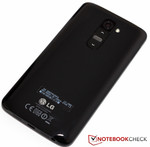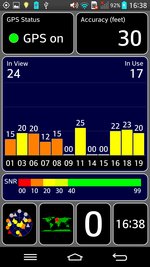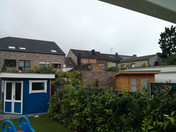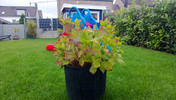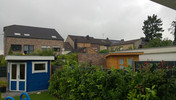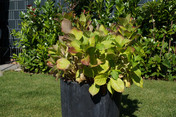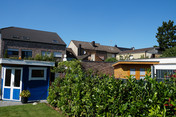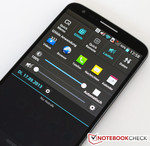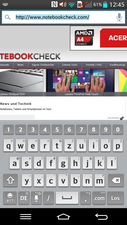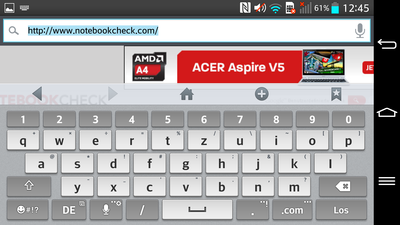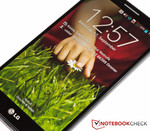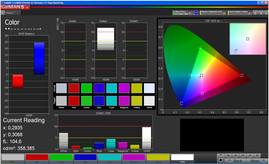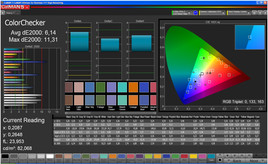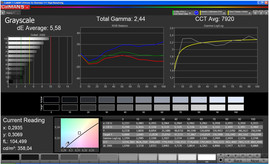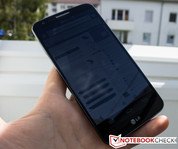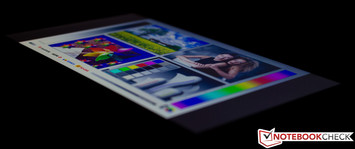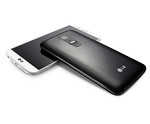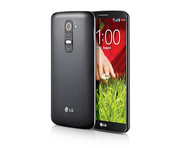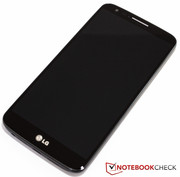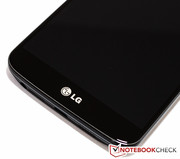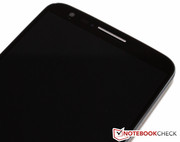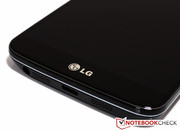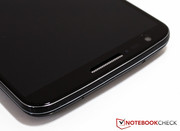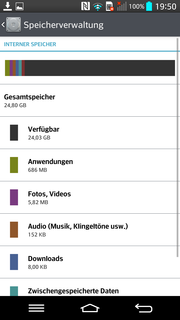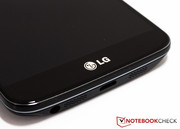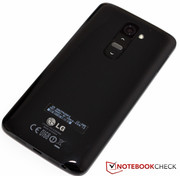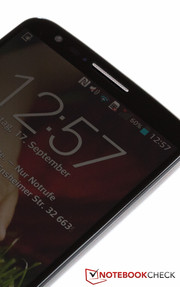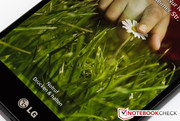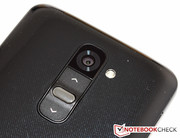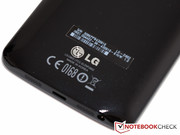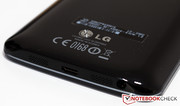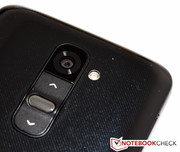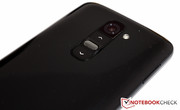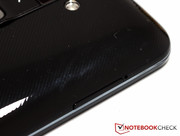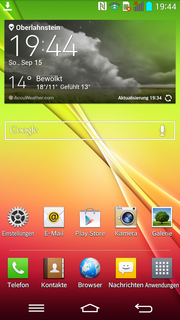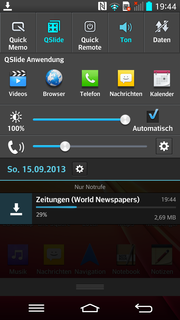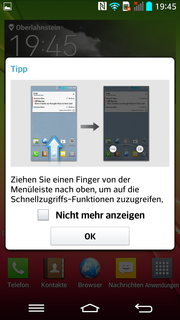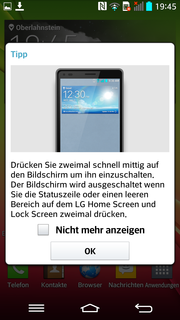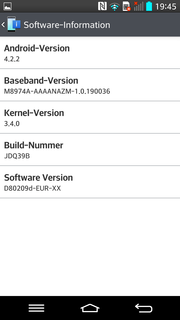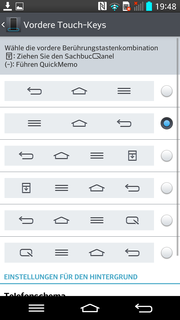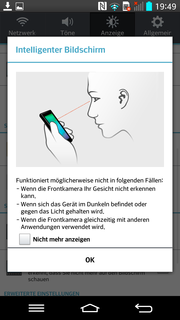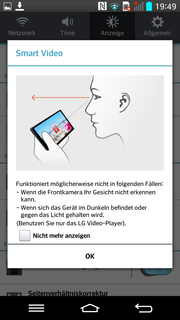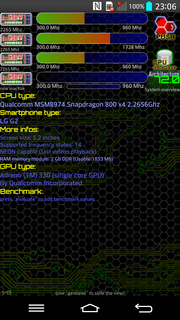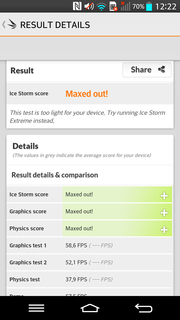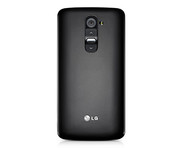Review LG G2 Smartphone
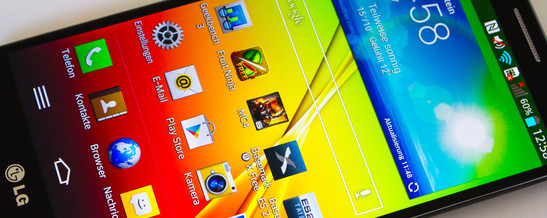
For the original German review, see here.
The South Korean manufacturer now offers its newest flagship in the smartphone sector with the LG G2. This 5.2-inch giant features an extremely swift SoC from Qualcomm. The power-hungry Cortex A15 processor supplies a great deal of power as fast as possible with four cores and a clock rate of 2.3 GHz each. It is supported by the Adreno 330 GPU, 2 GB of working memory and 32 GB of internal flash memory that unfortunately cannot be expanded. We noticed great similarities in the review of the former high-end Optimus G E975 smartphone and the Nexus 4. Perhaps the G2 is a forerunner of the hardware to be used in the Nexus 5 - we remain curious. However, we will now look closer at the hardware and software combination of the review sample and find out where its strengths and weaknesses are.
Case
LG has opted for a plastic casing in favor of weight. The back features rounded sides and the looks of textured polycarbonate. However, it cannot belie that it is sleek, glossy plastic when it is held in the hand - a magnet for fingerprints. Unfortunately, the back cover cannot be removed. Nevertheless, the G2 is rigid, makes a quality-build impression and is resistant to selective pressure. It easily defies attempts to twist it no matter in which direction.
The G2 is visibly bigger than its precursor with 138.5 x 70.9 x 9.14 mm. That is not surprising in view of a 0.5 mm larger screen. Its weight compensates that since it is 5 grams lighter than the Optimus G E975.
Connectivity
Currently, a largely standardized positioning of interfaces and buttons has been established. Now a manufacturer finally breaks with this "tradition" and applies an innovative system. We were a bit stumped at the first hands-on because searching for the power button on the sides proved fruitless. Our first challenge was turning on the phone. It is naturally embarrassing to look in the manual for help and thus we wildly groped the entire casing. We deemed the buttons below the primary camera as odd. Obviously, the power button on LG's phone has now been centered on the phone's back because pressing it turned on the G2. The arrangement of buttons is as follows: The volume rocker is directly below the camera and encompasses the power button. All four sides of the casing are void of buttons. Only the micro-USB port, the 3.5 mm jack and the stereo speaker are located on the lower edge.
LG relies on a flash memory with a capacity of 32 GB for storing data. It cannot be expanded with a micro SD card.
Software
Google's Android version 4.2.2 is first choice when it comes to the operating system. After all, there was a close cooperation with the search engine giant in the past. For example, Google's Nexus 4 comes from LG's factories and it is currently still unclear whether and what role the South Korean company will have in the Nexus 5.
LG installs its own launcher and has modified various items in the system settings. The user, for example, can alter the assignment order of the navigation softkeys or control features like Intelligent Screen (screen remains on as long as it is looked at) or Smart Video. There is also enough bloatware on the G2. Life Square, LG Backup, SmartWorld and Safety Care are preinstalled on the phone, although many software programs will not please every buyer.
Communication & GPS
To attain a leading position among the Top 10 Smartphones, there must not be a lack of communication and interfaces. The LTE wireless module basically enables a sufficiently fast data connection (42.2 Mbit/s downstream), providing the mobile network supports that. The G2 can connect to Wi-Fi networks in the 802.11 b/g/n standards and Bluetooth version 4.0 is also available for data sharing. In addition to the NFC technology, an infrared interface is also installed that can transform the smartphone into a universal remote control.
The aGPS module connects to satellites in orbit within a few seconds. The accuracy increases outdoors and GPS is throughout stable when the user is not standing in an underground garage for a longer time. All tested modules fulfill our standards and did not exhibit any negative qualities, such as signal interruption or a much too short range.
Telephony and Speech Quality
The South Korean manufacturer does everything right here. The sound quality is loud and clear when a sufficient degree of network coverage is available. A "voice enhancer" can improve this even more and the hands-free unit does a good job. Beyond that, the included in-ear headset is compelling although headsets with a better sound quality are available in the optional accessories.
Cameras & Multimedia
Pictures and video clips can be made with both the front and primary cameras of the G2. The rear-facing camera shoots pictures with a maximum resolution of 4368x2919 pixels which equals 13 MP. Videos can be recorded in Full HD quality with 60 frames per second. The sensor also features an image stabilizer and an LED flash is installed. The Dual Recording feature is interesting. It enables making a video or a picture with both camera modules at the same time. There are also numerous camera modes to choose from. For example, one function allows making 360° panoramas as known from the Nexus 4.
We evaluate the primary camera's quality based on many test shoots and by comparing them directly with other smartphones and our reference camera, Sony's Alpha A57. Overall, the 13 MP camera renders all objects with sufficient focus. The colors look natural and image noise is not visible in our outdoor shoots. All in all, a throughout satisfactory result.
Accessories & Warranty
We cannot expect surprises in every test section and LG has baffled us enough already with the new operating concept. The buyer can only expect to find a modular power supply and an in-ear headset in the scope of delivery.
The manufacturer includes a 24 month warranty on the phone in cases of accidental damage. The battery is only covered for 6 months. Claims can be filed via a hotline or repair request on the manufacturer's website.
Input Devices & Controls
A few paragraphs above we mentioned the new arrangement of the physical buttons. The physical button's relocation will likely not appeal to everyone. Users who do not want to permanently press the power button can reactivate the device from standby just by double-tapping on the disabled screen. It also works the other way around. A double-tap on an empty space on the home screen or on the status bar turns the screen off. This worked reliably in practice and is a real added value.
EWorking with the capacitive screen is just as accurate and easy, as befitting for a high-priced premium phone. The keyboard covers slightly less than 50% of the screen in portrait mode. This is because a number row and navigation buttons are permanently faded in above the letters. It is accordingly cramped in landscape mode.
Display
A 5.2-inch IPS screen is installed in LG's new flagship. It features an extremely high resolution Full HD screen. The review sample achieves a pixel density of 424 dpi with 1920x1080 pixels. That is a bit lower than in Samsung's S4 top model (440 dpi) and again lower than in HTC's One (468 dpi). We have to note the extremely narrow rim between the screen and casing. It had already been reduced to a minimum in Samsung's Galaxy S4 and LG's engineers have managed to reduce it even more.
We ascertained an average brightness of 330.1 cd/m² and a still acceptable illumination of 84% with our measuring device X-Rite i1pro 2. This results in a contrast of 1085:1 alongside a black value of 0.33 cd/m².
| |||||||||||||||||||||||||
Brightness Distribution: 84 %
Center on Battery: 358 cd/m²
Contrast: 1085:1 (Black: 0.33 cd/m²)
ΔE ColorChecker Calman: 6.14 | ∀{0.5-29.43 Ø4.78}
ΔE Greyscale Calman: 5.58 | ∀{0.09-98 Ø5}
Gamma: 2.44
CCT: 7920 K
Based on our assessments using the CalMAN 5 colorimeter software, we noticed that the screen has a light bluish cast and red colors are a bit too pale. However, this deviation from original is not particularly serious since the DeltaE is below 5. The screen's grayscale gradient is largely accurate although the color temperature reproduction is a bit too low.
The screen's low black value, high contrast and brightness are very good prerequisites for outdoor use. The screen excelled in the various situations outside of our rooms and provided a satisfactory result. To increase the screen's legibility to the max, a matte screen protector can be applied. It reduces fingerprints as well as reflections.
LG relies on a quad-core from Qualcomm for its new top model. The Snapdragon 800 has a clock rate of 2.3 GHz on each core and is supported by 2 GB of working memory. As before, it is based on the ARMv7 instruction set using 32-bit technology and is prepared for the new video format standard. "Ultra HD" is its name and enables a resolution of 3840x2160 pixels, which is four times as much as in the case of Full HD.
The Snapdragon 800's power is breathtaking. LG's G2 unceremoniously leaves all behind and dashes to the performance forefront. The contenders from Samsung, HTC and Google are very clearly defeated - in every synthetic benchmark. The score of 3DMark (2013) - Ice Storm Standard could no longer be put in figures. The app only displayed "Maxed Out".
| Geekbench 2 - 32 Bit - Total Score (sort by value) | |
| LG G2 | |
| Samsung Galaxy S4 GT-I9505 | |
| HTC One | |
| Google Nexus 4 | |
| LG Optimus G E975 | |
| 3DMark | |
| 1920x1080 Ice Storm Extreme Score (sort by value) | |
| LG G2 | |
| Samsung Galaxy S4 GT-I9505 | |
| Google Nexus 4 | |
| 1280x720 Ice Storm Standard Score (sort by value) | |
| LG G2 | |
| Samsung Galaxy S4 GT-I9505 | |
| HTC One | |
| Google Nexus 4 | |
| LG Optimus G E975 | |
| GFXBench (DX / GLBenchmark) 2.7 | |
| T-Rex Onscreen (sort by value) | |
| LG G2 | |
| Samsung Galaxy S4 GT-I9505 | |
| Google Nexus 4 | |
| LG Optimus G E975 | |
| 1920x1080 T-Rex Offscreen (sort by value) | |
| LG G2 | |
| Samsung Galaxy S4 GT-I9505 | |
| Google Nexus 4 | |
| LG Optimus G E975 | |
| Smartbench 2012 | |
| Gaming Index (sort by value) | |
| LG G2 | |
| Samsung Galaxy S4 GT-I9505 | |
| HTC One | |
| Google Nexus 4 | |
| LG Optimus G E975 | |
| Productivity Index (sort by value) | |
| LG G2 | |
| Samsung Galaxy S4 GT-I9505 | |
| HTC One | |
| Google Nexus 4 | |
| LG Optimus G E975 | |
| Linpack Android / IOS | |
| Multi Thread (sort by value) | |
| LG G2 | |
| Samsung Galaxy S4 GT-I9505 | |
| HTC One | |
| Google Nexus 4 | |
| LG Optimus G E975 | |
| Single Thread (sort by value) | |
| LG G2 | |
| Samsung Galaxy S4 GT-I9505 | |
| HTC One | |
| Google Nexus 4 | |
| LG Optimus G E975 | |
| Epic Citadel - Ultra High Quality (sort by value) | |
| LG G2 | |
| Samsung Galaxy S4 GT-I9505 | |
| Google Nexus 4 | |
The competition can regain a bit of ground in the browser-based benchmarks although the other premium smartphones have a hard time. For example, Apple's iPhone 5 only managed a 4% better result in Peacekeeper. Two further outliers were observed in Mozilla's Kraken V1. All in all, a runaway victory for our review sample in the browser-based benchmarks.
| Browsermark - --- (sort by value) | |
| LG G2 | |
| Samsung Galaxy S4 GT-I9505 | |
| HTC One | |
| Apple iPhone 5 | |
| Nokia Lumia 925 | |
| Sony Xperia ZL | |
| Octane V1 - Total Score (sort by value) | |
| LG G2 | |
| Samsung Galaxy S4 GT-I9505 | |
| HTC One | |
| Apple iPhone 5 | |
| Nokia Lumia 925 | |
| Sony Xperia ZL | |
| Peacekeeper - --- (sort by value) | |
| LG G2 | |
| Samsung Galaxy S4 GT-I9505 | |
| HTC One | |
| Apple iPhone 5 | |
| Nokia Lumia 925 | |
| Sony Xperia ZL | |
| Mozilla Kraken 1.0 - Total (sort by value) | |
| LG G2 | |
| Samsung Galaxy S4 GT-I9505 | |
| HTC One | |
| Apple iPhone 5 | |
| Nokia Lumia 925 | |
| Sony Xperia ZL | |
| Sunspider - 0.9.1 Total Score (sort by value) | |
| LG G2 | |
| Samsung Galaxy S4 GT-I9505 | |
| HTC One | |
| Apple iPhone 5 | |
| Nokia Lumia 925 | |
| Sony Xperia ZL | |
* ... smaller is better
To complete the triple, the G2's flash memory presented itself at its best. Never before had we observed the internal storage of a smartphone achieving a read speed of over 100 MB/s. The outcome here is clear: LG's G2 is the new current reference in terms of performance.
| AndroBench 3-5 | |
| Random Write 4KB (sort by value) | |
| LG G2 | |
| Samsung Galaxy S4 GT-I9505 | |
| HTC One | |
| Sony Xperia ZL | |
| Google Nexus 4 | |
| Random Read 4KB (sort by value) | |
| LG G2 | |
| Samsung Galaxy S4 GT-I9505 | |
| HTC One | |
| Sony Xperia ZL | |
| Google Nexus 4 | |
| Sequential Write 256KB (sort by value) | |
| LG G2 | |
| Samsung Galaxy S4 GT-I9505 | |
| HTC One | |
| Sony Xperia ZL | |
| Google Nexus 4 | |
| Sequential Read 256KB (sort by value) | |
| LG G2 | |
| Samsung Galaxy S4 GT-I9505 | |
| HTC One | |
| Sony Xperia ZL | |
| Google Nexus 4 | |
Games
Something would be wrong if the phone were not to achieve the full score in this test section - either in our test or by LG. Barely any application should put a quad-core with a clock rate of over 2 GHz and 2 GB of working memory under such pressure that problems will occur in the execution. Accordingly, our test videos were no major challenge for the smartphone, although they had a data rate of up to 6100 kBit/s and a Full HD resolution. The SoC is even apt for the upcoming "Ultra-High Definition" video format and should render that smoothly.
This looks pretty much the same with up to date 3D and 2D games. The power is far more than enough and does not push the review sample to its performance limits.
Emissions
Temperature
Such a powerful SoC produces a lot of waste heat that has to be discharged as fast as possible. The temperature profile illustrates how successful the designers were with this feat. The manufacturer accomplishes this satisfactorily with our review sample. We measured a load average of 36.5 °C on the front and 36.4 °C on the back with our Voltcraft IR-350. No rate exceeded 40 °C. The temperature clearly drops when the processor's workload is reduced to a minimum. A temperature ranging from 28.8 °C to 29.4 °C was measured in idle. A very good performance for such a device.
(+) The maximum temperature on the upper side is 38.7 °C / 102 F, compared to the average of 35.2 °C / 95 F, ranging from 21.9 to 247 °C for the class Smartphone.
(+) The bottom heats up to a maximum of 38.8 °C / 102 F, compared to the average of 34 °C / 93 F
(+) In idle usage, the average temperature for the upper side is 29.4 °C / 85 F, compared to the device average of 32.9 °C / 91 F.
Speakers
The speaker is also found in an unusual place. It is normally located on the device's back or, as in the case of HTC's One, on the front. In the case of this premium model, the speaker is on the left and right of the micro-USB port. Our ode to the G2 is continued here. LG does not focus on an extremely high volume but instead concentrates on a clear and mostly noise-free sound. The speaker's overall volume is quite low up to 50%. We first hear sound distortions when the maximum volume is reached. Of course, an equalizer is installed and it features pre-settings to choose from. Although it looks like there are two speakers installed, it is only one mono speaker.
Energy Management
Power Consumption
The huge screen and the quad-core SoC are satisfied with a low power consumption. The G2 consumes 0.4 to 1.4 watts when not executing computing-heavy tasks, such as videos or games. The Galaxy S4 (0.4 - 1.2 watts) and HTC One (0.4 - 1.4 watts) are also within this consumption range. Energy saving comes to an end as soon as the processor and its four cores run at full speed. With up to 4.8 watts, the G2 consumes 0.8 watts more than HTC's One but also 0.3 watts less than the Galaxy S4. We looked closer at whether and to what extent the ascertained consumption rates affect the real battery runtimes in the following test section.
| Off / Standby | |
| Idle | |
| Load |
|
Key:
min: | |
Battery Runtime
An A15 core with 2.3 GHz and the bright IPS screen want a lot of energy. Thus the battery runtime of our Wi-Fi test was even more surprising. 17 hours and 4 minutes passed before the G2 shut down. That is roughly twice as long as that of the Galaxy S4. The Galaxy S4 achieves a marginally better full load runtime. However, LG's G2 again surpasses HTC's One with 3 hours and 40 minutes vs. 2 hours and 49 minutes. When the SoC is idling, the battery runtime seems infinite - at least in comparison with the runtime of "normal" smartphones". The review sample gave an awesome performance with 23 hours and 16 minutes. It took 2 hours and 53 minutes to completely recharge the phone.
Verdict
The South Korean manufacturer has hit a home run with the LG G2. It is powered by the swift Snapdragon 800 quad-core SoC that features four cores with 2.3 GHz each. They are supported by 2 GB of working memory and the Adreno 330 GPU. Enough power is ensured. The IPS screen is 0.2-inches bigger than the screen in the Galaxy S4 and has an even narrower gap to the casing's edge. Deductions are made in the B-list grade because the storage cannot be expanded and the battery is non-removable. Also, an interesting arrangement of the physical buttons is apparent (power button, volume rocker). LG was innovative and places them below the primary camera. The screen can be turned on and off by double-tapping it. LG obviously did a proper job with its LTE flagship because the competition cannot in any way connect to its performance as can easily be seen in the benchmarks. The battery runtime is just as satisfying. The G2 achieves 17 hours in the practical Wi-Fi test when the screen is permanently on. The G2 will be available from September 30, 2013 for a street price of approx. 550 Euros (~$741). Only 20 Euros (~$26) less is demanded for HTC's One and the buyer has to count with 500 Euros (~$673) for the Galaxy S4. It certainly will not be easy to opt for one of the three phones. However, users who want extreme speed and cutting-edge hardware will not pass by LG's G2.




